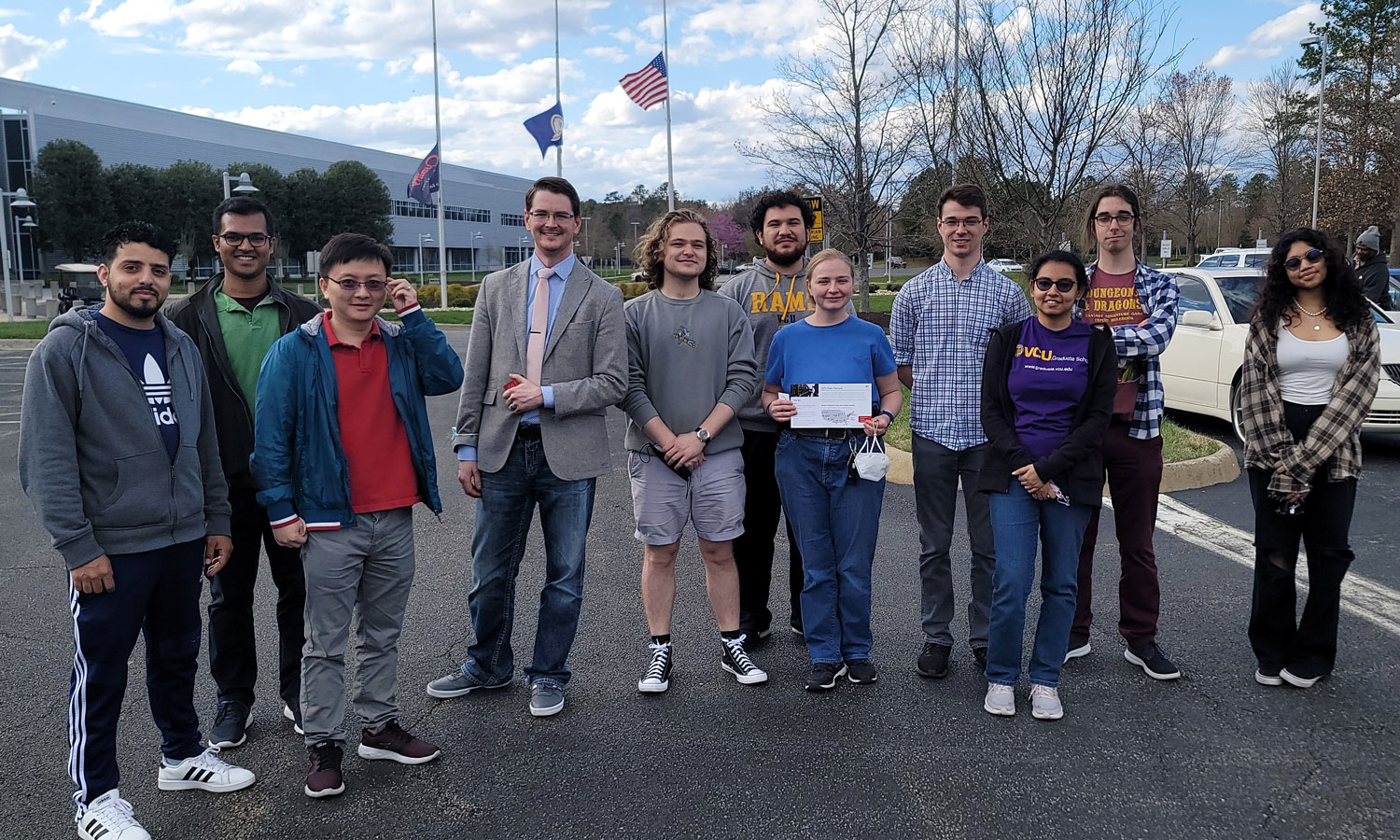The digital world is built upon a highway of light. Events like the recent International Data Center Day pull back the electronic veil and give an opportunity to discuss the technology behind the Internet. Each year, Nathaniel Kinsey, Ph.D. supports the event through Fiber Friday, a lecture series and discussion about optics, photonics and the roles they play within a data center.
This year’s Fiber Friday ended with a trip to a Quality Technology Services (QTS) data center in Sandston, Virginia. Unique to this data center is MAREA, an intercontinental fiber optic cable that terminates in Sandston. New York and Florida are the only two other states on the east coast supporting undersea, trans-continental cables. Sandston’s QTS data center is linked to its counterpart in Bilbao, Spain. (Click here to view an interactive map of all trans-continental data cables.)
Below, Kinsey answers some questions about data center fiber optics and his research.
Q: Tell us a little about your research and how it applies to technologies used in data centers.
A: In our work we look at developing new approaches to active devices that can dynamically control various properties of light such as its intensity or its polarization. We aim to make these devices very small, high-speed and efficient. To accomplish this, we utilize techniques of nanophotonics to squeeze light into nanoscale sizes and novel materials to control the light’s properties.
Our prototype devices could one day end up in new types of optical transceivers, devices that sit at the edge of every server in a data center to create and receive the optical pulses from optical fibers. Devices we create could also be used in new technologies like integrated silicon photonic circuits and optical neuromorphic processors, all unique avenues for continuing to advance our ability to process information at breakthrough speeds.
Q: What role do optics and photonics play in digitally linking our world together?
A: Anytime you access a website, stream a video or listen to a song, bits of data are being transmitted across the internet through optical fibers. Lasers on one end of a fiber create pulses of light that contain information while detectors on the other end receive the pulses and convert them back to electrical signals for devices to process. In fact, the entirety of global internet communication occurs through optical fibers, except over the last mile, and even this is changing. Many homes now have direct optical fiber connections. As a result, our digital world is entirely enabled by optical technologies.
Q: What makes light such an efficient way of transmitting data across long distances?
A: First and foremost, light is the fastest thing we have for communicating information so that is a big benefit. Secondly, the amount of data that you can send with light is much larger than with radio signals. This is because the frequency of light is about 100,000 GHz compared to radio signals which are around 1-10 GHz. It was the invention of optical fiber that truly made light the information highway.
Development of modern fibers, constructed from glass, enabled light signals to propagate for miles without losing intensity. This provides a low-cost platform and enables fiber optic lines to be easily buried or hung from existing poles while remaining free from weather, dust, and other contaminants. The combined benefit of light and the development of optical fibers makes light the best choice for long-distance communication.
Q: What role does materials development play in creating more efficient devices?
A: Materials development is fundamental to the creation of devices. While devices are largely based on well-developed materials sets such as silicon and silicon dioxide (glass), the construction of new devices generally requires the introduction of additional materials with unique features. These first-generation devices may not have the best performance, but with continued optimization of the materials and the integration methods, reliable and commercial-grade devices can be transitioned from the laboratory to consumer systems. It's not only the development of new materials that is important, but also the subsequent optimization and development of key platforms that lead to our breakthrough technologies.
Q: How is fiber optic technology evolving? What do you see as the next big innovation?
A: Fiber optic technologies continue to be a key technology for our modern society. One of the major advancements in this area over the last several years has been the development of novel types of fiber like photonic crystal fibers and active fibers. These developments have impacted technologies beyond communications and have enabled new types of so-called “white light laser sources” as well as fiber sensors and lasers in new wavelength bands such as the ultraviolet and infrared spectrums.
Fibers are also becoming increasingly important to medical technologies, allowing small and versatile optical sensors and imaging technologies. One new advancement I see coming on the horizon is mass commercialization of silicon photonic circuits and their integration with optical fiber. Leveraging the well-developed silicon processing technologies from the advanced semiconductor industry, we are now able to create small circuits of light similar to electrical circuits. These devices can perform various operations on data in tiny spaces such as neural networks and even optical processors.
Connecting these new photonic integrated circuits with the optical fiber network opens many new avenues for high-speed optical processing and perhaps even a quantum internet in the future.
Q: So you mention a device called a photonic integrated circuit, what is that and how do you make them?
A: Photonic integrated circuits are typically made from silicon chips and contain numerous optical components that are much smaller than the size of a hair. They are constructed using cutting edge nanofabrication techniques to pattern, etch, deposit and layer various materials to construct devices by leveraging the technologies used to develop cutting edge electrical processors.
Similar to electrical integrated circuits, photonic integrated circuits are fabricated in cleanrooms. These highly-controlled environments remove dust and other contaminants, which are thousands of times larger than the nanodevices on the photonic integrated circuit.
